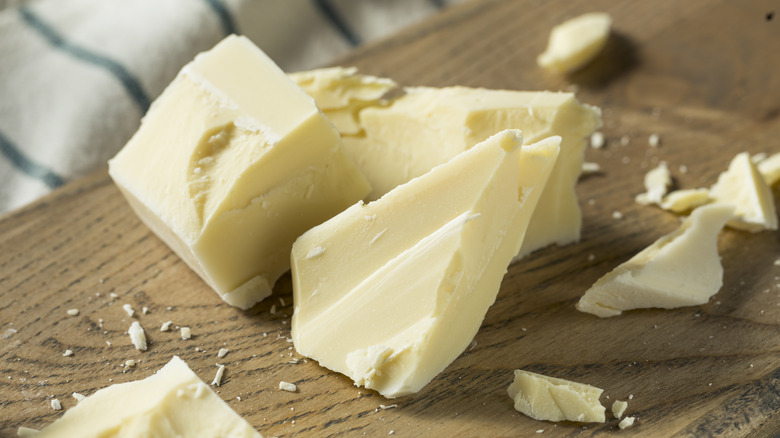What Makes Blonde Chocolate Different From White Chocolate?
Blonde chocolate is enjoying its moment in the spotlight. Everywhere you look, people are extolling the unique sweet's properties in cookbooks and sharing blonde chocolate recipes on social media. Some popular candy companies have even released blonde chocolate products because demand is so high.
But what is blonde chocolate, and how is it made? Blonde chocolate is exceptionally easy to confuse with white chocolate, especially since they look somewhat alike. But they're not actually the same thing. This is most apparent in their taste: Blonde chocolate is full of nutty, caramelized notes, while white chocolate is more simply sweet. They also look fairly different. White chocolate is a creamy ivory, with occasional tints of yellow. Blonde chocolate, in contrast, is a richer golden color, often bordering on bronze and outright brown. Yet they both share the same origin. How can this be? It's simple: Blonde chocolate is just white chocolate that's been caramelized. This slight but significant difference opens up a whole new world of culinary possibilities.
The difference between white chocolate and blonde chocolate
It seems like blonde chocolate only entered the culinary scene recently. This is half true: As far as chocolate goes, it's pretty young, but it's not an invention of the last few years. Blonde chocolate was first created less than two decades ago, in 2004. White chocolate is far more established, having graced our cookies and brownies since the 1930s. But it isn't just blonde chocolate's relative newness that separates it from white chocolate.
Blonde chocolate begins as white chocolate. It is then chopped up and cooked at a low temperature over a long period of time. This caramelizes the chocolate through a process known as the Maillard reaction — aka, the reaction that turns everything from sourdough loaves to casseroles to soufflés into golden-brown deliciousness. Thanks to caramelization, blonde chocolate has a toasty, nutty, butterscotch-y flavor. It's delicious, complex, and best of all, easy to make at home. That's right — you don't need to be a pastry chef or a professional candy-maker to bring blonde chocolate to your very own kitchen.
How to make blonde chocolate
To get started making blonde chocolate, make sure you have white chocolate in bar form so that you can easily chop it. Line a baking tray and lay out your white chocolate. Once you start heating the chocolate in the oven, remove and stir it every few minutes until it's been caramelized to your taste. (The more caramelization, the richer the flavor will be.) Then, use a spatula to smooth and spread the chocolate before pouring it into a cake pan to set. Once the chocolate has a firm texture, you'll have your very own block of blonde chocolate.
White chocolate and blonde chocolate may be different in flavor, but blonde chocolate is a great substitute for white chocolate in a variety of recipes. White chocolate blondies are delicious, but swapping in blonde chocolate can make them an even more deliciously toasted experience. Candy bark is another great application — just think about how good blonde chocolate bark with almonds could be. The possibilities are endless.


